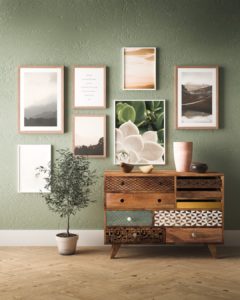Its Influence on our Subconscious
With most of our lives spent indoors, and even more so during the Covid-19 pandemic, the space we occupy has a major role in our psychological behavior. Environmental psychology – or interior design psychology – is about the interaction between people and the spaces they inhabit. Architecture acts as a trigger to physical, physiological and psychological well-being. From inducing warmth and safety to creating a positive and efficient working environment, interior design has a huge impact on how we act and on what we feel. It recognizes the importance of colors, light, personalities, space, proportions, acoustics, materials, energy, etc.
Your choice of design defines you but also influences your subconscious, the psychology of your guests and how they perceive you. The decisions that you make when deciding how your home will look have a documented effect on your emotions and perceptions.
Color Choice Affects Your Mood
Color is a big part of how we experience the world. They can promote feelings from tranquility to anxiety. While some shades, like red and orange, induce passionate and energetic feelings, others like green and blue, have more soothing effects. Different colors can capture different moods. For example:
- Red: Symbolizes power and passion. It can be used to make the décor feel warmer and more intimate.
- Blue: Perpetuates feelings of calm and freshness. It’s a good fit for kitchens and bathrooms.
- Green: Known for its soothing qualities. Green is the perfect choice for a foyer or entryway because it eases the transition from the outdoors.
- Brown: Like green, brown’s natural roots give it a relaxing touch. It works well for rooms where the family gathers and furniture groupings that will incite conversation.
- White: Represents purity and cleanliness. It is great for defining a space and making it look larger as well. But remember to use white in conjunction with other colors since too much will look too sterile.
 https://bravosabi.com/
https://bravosabi.com/
Perception of Space is key
An open space leads to an open mind. It brings more positive energy into your home, while if you are cocooned in a small dark area, your mood may shift towards a more negative side.
Large windows, mirrors, glass doors, or skylights that let in a lot of natural light, provide the sense of greater area. Creating lines using the room’s furnishings and structural design can also help shape the room, guide the eye and form harmony, unity and contrast.
- Horizontal lines, created by tables and other surfaces, give a sense of stability, formality and efficiency. They make a room appear wider and longer.
- Vertical lines, created by features such as windows and doorways, evoke feelings of freedom and strength. They often give the illusion of a room being taller.
- Dynamic lines refer to diagonal, zigzag or curved lines. Such lines can be found in stairs, for example, and provide energy and movement. They capture our attention longer.
Less is pretty much always more
Clutter in your space often means clutter in your brain, heart and life. The Marie Kondo method is defined as “a system of simplifying and organizing your home by getting rid of physical items that do not bring joy into your life.” A space that doesn’t crowd you and gives you room to think and breathe contributes greatly to your wellbeing.
Natural light is your best friend
Studies have shown that mood and energy levels are directly related to how much natural light we receive daily. While nothing beats natural sunlight, there is nothing wrong with artificial light. But be intentional about it.
Warm lighting can make you feel warm on the inside. It is calming and puts the minds at rest. Blue lighting, on the other hand, is cold and very difficult to feel relaxed in. When creating a safe space consider Edison bulbs, Himalayan salt lamps, bistro lights and other forms of light that feel as natural as possible.
Your home design unconsciously shows your personality
In his book, The System of Objects, sociologist Jean Baudrillard argues that the combination of every item that fills an interior – from the seating arrangements to the wall hangings, and down to the coasters that sit on your coffee table – acts as an expression of our personalities and desires.
Feng Shui your living spaces
Also known as Chinese geomancy, Feng Shui is a practice that uses energy forces from the surrounding environment to bring harmony to individuals. Practicing its principles is believed to attract success, good luck, love and positive energy.
True adherence requires practitioners to analyze each space with a bagua, or energy map, and then use those readings to determine each aspect of their décor – colors, natural materials used. While going the full distance may not be feasible for everyone, you can still add subtle feng shui touches to improve the energy in your home:
- Make sure your entrance is clean, colorful, warm and welcoming.
- Arrange the furniture in a way that allows you to see the doorway clearly, and that would appear inviting to guests.
- Decorate with natural elements like flowers, plants and stones.
- And again, remember to keep your home clean and clutter-free.
But the most important thing of all is to find what is right for YOU.
Every one of these choices has a psychological impact. Be intentional about it. Find your own style and colors. Find your art/heart. Find your vibe. And create a space for yourself that feels safe, calming, inspiring, peaceful and harmonious for both the body and mind.
